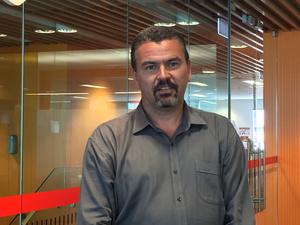CIO100 2017 #22: Ed Overy, KiwiRail

Ed Overy has overseen a significant transformation of the entire ICT organisation at KiwiRail over the past year-and-a-half.
“We were wholly insourced, owner operator of IT infrastructure and services,” says Overy of the situation at the state-owned enterprise, prior to the transition.
“A large proportion of ICT resource and effort was allocated to low value activity instead of business change. We had a high fixed cost base.”
“Our CEO Peter Reidy challenged us to do things differently,” he says.
What followed was a review of their organisational landscape which determined how best to deliver the IT services the businesses needed.
“It was a significant change management and people leadership exercise,” says Overy. “ICT at KiwiRail is now a high performing, contemporary, multi-vendor, engaged organisation.”
They did this by outsourcing the ‘run’ functions and migrating their infrastructure to Revera IaaS cloud. Service management and end user services were outsourced to Spark Digital, while project management and PMO function outsourced to LPS, says Overy. “We retained the key IP functions of applications and architecture.”
By December 2016, the team had completed the migration of 700+ servers, two petabytes of storage, and over 200 business applications. The ICT staff count was reduced from 165 full time employees to 50. Some of them joined outsourcing partner Spark, or joined other business units at KiwiRail.
There has been law attrition level since, says Overy.
“Key criteria for transition success was that for the business, change was invisible and services were improved,” says Overy. “Business interruption has been minimal.”
For ICT, the criteria were ITIL metrics of service performance, availability, security and risk. Financial targets for operational and capital expenditures were set.
He says application teams are now beginning to be self-managed service owners, as the team adopted ‘agile-lite’ and some DevOps attributes.
We achieved a high level of service maturity, he says. “A culture of accountability and ownership exists in the teams.”
“The outsourcing of ‘commodity IT’ infrastructure, operations and service management was deliberate effort to ensure that all of the IT team’s efforts are focused outwards and on the business and our customers,” says Overy.
“The focus to date has been to optimise and incrementally improve existing systems. By significantly reshaping the IT organisation, we are now poised to work much more strategically alongside the business seeking ways in which technology may help improve business outcomes.”
Optimising data
During this period, the ICT team provided critical support for a major business project, the fuel conservation programme. The goal was to reduce consumption and eliminate energy waste in train operations. Overy explains that several attempts in the past to achieve this were difficult to sustain over the long term as these relied heavily on individual behaviour.
“We haven’t had robust processes or technology to monitor and manage compliance.”
The team helped with the introduction of a new technology called Driver Advice System (DAS). DAS works by recommending a locomotive- and route-specific driving style that optimises energy use while keeping the train to timetable. Safe train operation is always the priority and how the train is driven is ultimately decided by the locomotive engineer, he explain.
Installing DAS in four different classes of locomotives meant each class required an IT interface system with specific design and install requirements.
Comprehensive testing on the locomotives, including a human factors study, was undertaken to eliminate any safety issues. The system needed to be compatible with KiwiRail’s other onboard equipment and not interfere with the track signaling systems.
An individual DAS unit needed to be installed in each of the 170 locomotives and this varied across each of the four classes. System communications are via mobile networks.
“Given New Zealand’s rugged terrain, ensuring provision of feedback for continuous improvement and up-to-date track condition data is a challenge and significant work was required to get this function working,” says Overy. The information collected such as journey logs and compliance statistics is used to improve the fuel-saving performance. The ideal profile is compared with the actual profile to identify the cause of differences, and develop solutions around these.
Overy says In the first year of partial operation, a 6 per cent fuel saving was achieved. “This amounts to 3.2 million litres being saved and 8,800 tonnes of greenhouse gas emissions being avoided.”
Overy says part of this role involves monitoring the potential impact of new technologies on the business, and to keep the leadership abreast of developments.
He has presented to the board and executive team some of the areas they are looking at, like how Internet of Things or sensors can help in their asset management and supply chain; and the impact of autonomous vehicles on transport, particularly on freight.
For Overy, a key component of his and his team’s work is continuous engagement with the rest of the organisation.
Critical engagements and partnerships
“Working closely with the business and aligning strategies,” is a key component of how Overy’s team works across the organisation.
He has appointed an IT business partner who is charged with managing the relationship between IT and their business customers. The scope includes managing the portfolio of work and prioritising the allocation of resources.
The enterprise architecture team, meanwhile, works directly with the business functions to elicit future requirements and capture these in the ICT strategic roadmaps.
Assessing their transformation programme, Overy states: “We are leaner, faster moving, we mitigated a lot of risks and we are using contemporary practices and approaches.”
Divina Paredes